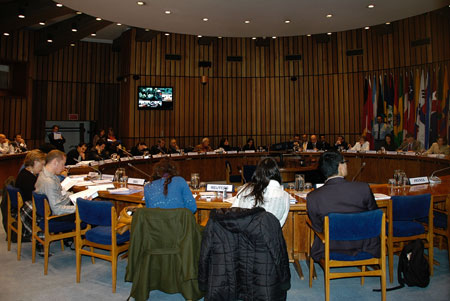Foreign Direct Investment in Latin America and the Caribbean Expected to Rise 40%-50% in 2010
Topic(s)
The international expansion of trans-latin companies continued in 2009, although their foreign investment flows diminished compared to the previous year.

Watch multimedia presentation (in Spanish)
(05 May 2010) Foreign direct investment (FDI) flows to Latin America and the Caribbean will rebound in 2010, rising 40% to 50%, after dropping in 2009 as a result of the global crisis, according to ECLAC's annual report on FDI released today.
The report Foreign Direct Investment in Latin America and the Caribbean 2009 asserts that the expected increase this year would allow the region to resume the levels of FDI of 2007, which totaled over US$100 billion.
"Now that the storm has passed, we see that the region has once again become an interesting place for investment. Our countries have not lost their attraction or competitiveness, in spite of the crisis," said Alicia Bárcena, Executive Secretary of the Economic Commission for Latin America and the Caribbean (ECLAC) during the presentation of the report at Commission headquarters in Santiago, Chile.
FDI is expected to rise significantly in 2010 due to a better outlook for growth in Latin America and the Caribbean, long-term trends of foreign investment in the region and expected inflows to the area's main recipient countries.
Due to the global crisis, in 2009 FDI flows to the region shrunk by 42% (to US$76.681 billion) with regard to the historical record of US$131.938 billion in 2008.
This decrease is explained by a combination of factors: a fall in world production, prevailing uncertainty and the deceleration of growth in several countries of the region, which discouraged FDI in search of local markets. In addition, falling commodity prices in late 2008 warded off investment in the exploitation of these resources, while the recession in North America restrained investment in export platforms.
The drop in foreign investment was generalized in all of the subregions in Latin America and the Caribbean. FDI flows towards South America diminished 40%, while those to Mexico and the Caribbean Basin dropped 45%. Brazil continued to be the main recipient of FDI, followed by Chile, México, Colombia and Argentina. Among the region's medium-sized and large economies, Chile is the country with the highest proportion of FDI with regard to its GDP (8%).
As in the past, the services sector received the most amount of FDI in 2009, while the primary sector (agriculture, mining and hydrocarbons) experienced a relative drop. The United States continued to be the main investor in the region, followed by Spain and Canada.
The ECLAC report notes that most announced FDI in manufacturing continues concentrated in low and medium-low technology intensive activities, while FDI in high-tech sectors and research and development projects is still scarce.
This reveals that two decades after FDI flows were liberalized, the region still has difficulties attracting high-technology investment and participating in high value-added links in global production chains.
To overcome these problems, the report suggests policies for productive development focused on innovation and strengthening local capabilities.
Latin American companies continued expanding internationally during 2009, says the twelfth issue of the report Foreign Direct Investment in Latin America and the Caribbean.
Chile was the region's main foreign investor, with US$7.983 billion, followed by Mexico (US$7.598 billion), Colombia (US$3.025 billion) and the Bolivarian Republic of Venezuela (US$1.800 billion).
The report also examines the automobile and iron and steel industries, both with significant participation of multinational companies and trans-latins.
The iron and steel industry attracted significant amounts of investment, especially Brazil and Mexico, which produce 51% and 27% of all steel in the region, respectively. The abundance of iron mineral was the main factor encouraging investment. In addition to European and Asian companies, Latin American companies (trans-latins) from Brazil, Mexico and Argentina also increased foreign investment over the past decade.
Although steel consumption in the region fell 24% in 2009, recovery was faster than expected, and unlike prior crises, installed capacity was not hampered by the closure of plants.
In its case study of the automobile industry, the report examines the situation in Brazil, which has become one of the world's biggest producers and one of the main consumer markets in the industry. The report also analyzes the case of Mexico, whose industry is highly dependent on exports to North America and was strongly impacted by the global crisis.
See also:
- Chart. Latin America and the Caribbean: Foreign Direct Investment Income by Recipient Country and Territory, 2000-2009
- Presentation by Alicia Bárcena, ECLAC Executive Secretary (in Spanish) Watch multimedia presentation (in Spanish)
- Fact sheet on the iron and steel industry
- Fact sheet on the automobile industry
The report Foreign Direct Investment in Latin America and the Caribbean 2009 is available on the ECLAC webpage following the link.
For more information, contact ECLAC's Information Services. Email: dpisantiago@cepal.org; telephone: (56-2) 210-2040/2149.
Attachment(s)
Related content
Industria automotriz
Hoja informativa sobre la industria automotriz mundial y la participación de América Latina.
Industria siderúrgica
Contiene información sobre empresas siderúrgicas transnacionales en América Latina y la producción de acero en 2008.
La inversión extranjera directa en América Latina y el Caribe 2009
Presentación de Alicia Bárcena, Secretaria Ejecutiva de la CEPAL. Santiago, Chile, 5 de mayo de 2010.
Country(ies)
- Latin America and the Caribbean
Contact
Public Information Unit
- prensa@cepal.org
- (56 2) 2210 2040